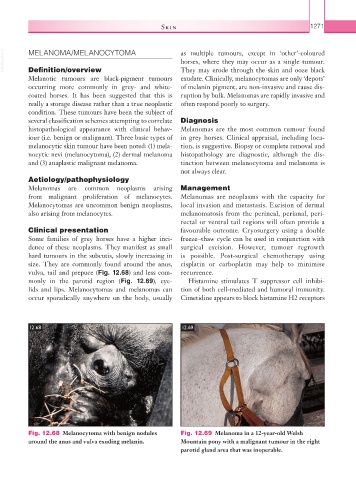Page 1296 - Equine Clinical Medicine, Surgery and Reproduction, 2nd Edition
P. 1296
Skin 1271
VetBooks.ir MELANOMA/MELANOCYTOMA as multiple tumours, except in ‘other’-coloured
horses, where they may occur as a single tumour.
Definition/overview
Melanotic tumours are black-pigment tumours They may erode through the skin and ooze black
exudate. Clinically, melanocytomas are only ‘depots’
occurring more commonly in grey- and white- of melanin pigment, are non-invasive and cause dis-
coated horses. It has been suggested that this is ruption by bulk. Melanomas are rapidly invasive and
really a storage disease rather than a true neoplastic often respond poorly to surgery.
condition. These tumours have been the subject of
several classification schemes attempting to correlate Diagnosis
histopathological appearance with clinical behav- Melanomas are the most common tumour found
iour (i.e. benign or malignant). Three basic types of in grey horses. Clinical appraisal, including loca-
melanocytic skin tumour have been noted: (1) mela- tion, is suggestive. Biopsy or complete removal and
nocytic nevi (melanocytoma), (2) dermal melanoma histopathology are diagnostic, although the dis-
and (3) anaplastic malignant melanoma. tinction between melanocytoma and melanoma is
not always clear.
Aetiology/pathophysiology
Melanomas are common neoplasms arising Management
from malignant proliferation of melanocytes. Melanomas are neoplasms with the capacity for
Melanocytomas are uncommon benign neoplasms, local invasion and metastasis. Excision of dermal
also arising from melanocytes. melanomatosis from the perineal, perianal, peri-
rectal or ventral tail regions will often provide a
Clinical presentation favourable outcome. Cryosurgery using a double
Some families of grey horses have a higher inci- freeze–thaw cycle can be used in conjunction with
dence of these neoplasms. They manifest as small surgical excision. However, tumour regrowth
hard tumours in the subcutis, slowly increasing in is possible. Post-surgical chemotherapy using
size. They are commonly found around the anus, cisplatin or carboplatin may help to minimise
vulva, tail and prepuce (Fig. 12.68) and less com- recurrence.
monly in the parotid region (Fig. 12.69), eye- Histamine stimulates T suppressor cell inhibi-
lids and lips. Melanocytomas and melanomas can tion of both cell-mediated and humoral immunity.
occur sporadically anywhere on the body, usually Cimetidine appears to block histamine H2 receptors
12.68 12.69
Fig. 12.68 Melanocytoma with benign nodules Fig. 12.69 Melanoma in a 12-year-old Welsh
around the anus and vulva exuding melanin. Mountain pony with a malignant tumour in the right
parotid gland area that was inoperable.

